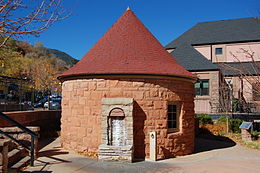Manitou Mineral Springs
|
Manitou Springs Historic District
|
|

Shoshone Spring, Manitou Avenue
|
|
| Location | Manitou Springs, Colorado |
|---|---|
| Coordinates | 38°51′28″N 104°55′14″W / 38.85778°N 104.92056°WCoordinates: 38°51′28″N 104°55′14″W / 38.85778°N 104.92056°W |
| NRHP Reference # | 83003516 |
| Added to NRHP | 1983 |
Manitou Mineral Springs are natural mineral springs in Manitou Springs, Colorado and Cheyenne Spring House is on the National Register of Historic Places. The springs are located in one of the country's largest National Historic Districts.
Manitou Springs, also called "Saratoga of the West", was established as a resort community, known for its mineral springs and "spectacular setting" at the edge of the Rocky Mountains and the base of Pikes Peak.
The spring water of Manitou Springs originates from two sources. "Deep-seated waters" of Rampart Range and Ute Pass provide one source of mineral water. Water below the surface is run through cavernous drainage systems called karst aquifers. Limestone in the water dissolves and resulting carbonic acid, or carbon dioxide, make the water "effervescent". The water rises to the surface naturally. This process is an artesian process where as water rises through layers of rock it picks up minerals and soda, or sodium bicarbonate. Some of the spring water also comes from "surface" waters from the watershed basins of Fountain Creek and Williams Canyon. Each spring has a different mineral content and because of that, a different taste.
The town has several mineral springs, called manitou for the "breath of the Great Spirit Manitou" believed to have created the bubbles, or "effervescence", in the spring water. The springs were considered sacred grounds where Native Americans drank and soaked in the mineral water to replenish and heal themselves. Ute, Arapaho, Cheyenne and other plains tribes came to the area, spent winters there, and "share[d] in the gifts of the waters without worry of conflict." There were 9 or 10 natural springs. As whites moved in there were "skirmishes" for access to the historical resort area until the Native Americans were removed from the area and placed on reservations.
Explorer Stephen Harriman Long made note of the water's healing properties in 1820. His expedition's botanist and geologist, Edwin James, noted the healing benefits of the water; He was also the first European man believed to have climbed Pikes Peak. George Frederick Ruxton wrote of the "boiling waters" in a book about his travels. Recognizing the extent to which Native Americans considered the site to be sacred, Ruxton wrote: "…the basin of the spring (at Manitou) was filled with beads and wampum, and pieces of red cloth and knives, while the surrounding trees were hung with strips of deer skin, cloth and moccosons (sic)."
...
Wikipedia


